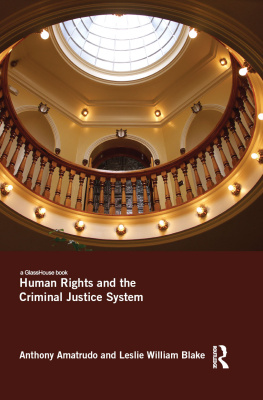INFORMATION
TECHNOLOGY
and the
Criminal Justice System
INFORMATION
TECHNOLOGY
and the
Criminal Justice System
Editor
APRIL PATTAVINA
University of Massachusetts at lowell
Copyright 2005 by Sage Publications, Inc.
All rights reserved. No part of this book may be reproduced or utilized in any form or by any means, electronic or mechanical, including photocopying, recording, or by any information storage and retrieval system, without permission in writing from the publisher.
For information:
| Sage Publications, Inc. 2455 Teller Road Thousand Oaks, California 91320 E-mail: |
Sage Publications Ltd. 1 Olivers Yard 55 City Road London, EC1Y ISP United Kingdom |
Sage Publications India Pvt. Ltd. B-42, Panchsheel Enclave Post Box 4109 New Delhi 110 017 India |
Printed in the United States of America on acid-free paper.
Library of Congress Cataloging-in-Publication Data
Information technology and the criminal justice system / edited by April Pattavina.
p. cm.
Includes bibliographical references and index.
ISBN 0-7619-3018-3 (cloth) ISBN 0-7619-3019-1 (pbk.)
1. Criminal justice, Administration ofData processing. 2. Criminal justice, Administration ofInformation services. 3. Information storage and retrieval systemsCriminal justice, Administration of. I. Pattavina, April.
HV7412.4.I54 2005
364.0285dc22 2004013903
04 05 06 07 08 09 10 9 8 7 6 5 4 3 2 1
Acquiring Editor: | Jerry Westby |
Project Editor: | Claudia A. Hoffman |
Copy Editor: | D. J. Peck |
Typesetter: | C&M Digitals (P) Ltd. |
Indexer: | Molly Hall |
Cover Designer: | Janet Foulger |
Contents
SECTION I: ADVANCES IN CRIMINAL
JUSTICE INFORMATION TECHNOLOGY
SECTION II. THE CRIMINAL JUSTICE
SYSTEM AND THE INTERNET
SECTION III. INFORMATION TECHNOLOGY
AND CRIME REPORTING AND ANALYSIS
SECTION IV. INFORMATION TECHNOLOGY
ISSUES IN CRIMINAL JUSTICE AGENCIES
Preface
T his book is about the impact that advances in information technology (IT) have had on the criminal justice system over the past several decades. Given the substantial investments that federal, state, and local criminal justice agencies are making in IT, the time is appropriate to begin synthesizing the growing body of information about IT and criminal justice in a way that frames the discussion in terms of what we have learned from past experiences, what the current state of IT is in various components of the criminal justice system, and what challenges lie ahead.
From this perspective, the goal of this book is to inform readers that computer and IT should be understood as more than just a set of tools designed to accomplish a discrete set of job tasks. As the chapters in this book illustrate, there are many technical, analytic, legal, and organizational issues related to advances in computer technology and IT. Therefore, IT must be considered as an integral component of understanding how our criminal justice system works.
There are many types of IT that could be topics of discussion for a book of this sort. Any attempt to enumerate and describe each in detail would likely be outdated by the time this work is published. The specific types of IT that are described in this book were selected because they address some perennial questions regarding IT and criminal justice and because they span across a variety of agencies, including police, courts, and corrections. These questions are as follows:
- How has IT changed the way in which we monitor criminal behavior?
- How has IT changed the way in which we examine patterns of criminal behavior?
- How have criminal justice organizations adapted to the use of IT?
- What is the future of IT in criminal justice?
The first section of the book deals with advances in criminal justice IT. In , Lois Davis and Brian Jackson provide an in-depth investigation of the major sources of IT support for criminal justice agencies and how those developments have shaped the current state of IT in agencies as well as how agencies have managed the acquisition and implementation of IT projects. They also discuss some lessons learned from past experiences with IT implementation in criminal justice agencies.
The second section of the book deals not only with how criminal justice agencies use the Internet but also with how criminals use the Internet. The subject of the construction of our understanding of cybercrime and its relationship to enforcement.
The third section of the book focuses on IT and crime reporting and analysis. In , April Pattavina discusses geographic information systems (GIS) and crime mapping in criminal justice agencies. In addition to GIS applications in criminal justice, she pays specific attention to issues of data quality.
The fourth section of the book includes chapters that provide in-depth analysis into IT development in specific agencies. In , Peter Manning illustrates the importance of organizational context in understanding how IT is implemented and used by those who work in police agencies.
The final section of the book addresses the future of IT in criminal justice. In , James Byrne and Eve Buzawa discuss the need for a criminal justice curriculum that focuses on developing the knowledge, skills, and analytic tools available in the area of IT. The final chapter, by April Pattavina, includes a discussion of the future prospects and challenges of IT in the criminal justice system.
The ultimate purpose of this book is to enhance our understanding of IT in criminal justice as a continuous process that will constantly challenge us to think about how we turn criminal justice information into knowledge, who can use that knowledge, and for what purposes. The incredible pace at which IT advances are being made is fascinating, and the opportunities for involvement undoubtedly will grow. Any person who is interested in criminal justice issues must develop the capacity to understand, use, and challenge current IT practices if he or she wishes to successfully contribute to the future of the field.
Section I
ADVANCES IN CRIMINAL
JUSTICE INFORMATION
TECHNOLOGY
CHAPTER
Information Technology
and the Criminal Justice System
An Historical Overview
TERENCE DUNWORTH
T he purpose of this chapter is to provide an historical perspective for the most prominent changes in information technology (IT) use that have taken place in the criminal justice field over the past several decades. Given that the field consists of more than 18,000 police departments and several thousand prosecutorial, court, and corrections agencies, it is clear that the objective can be met only in the most general terms. The agencies that comprise the criminal justice system are at highly varying stages of IT sophistication and use. They also have different motivations for initiating IT change. To illustrate, we may consider that an agencys objectives when making IT decisions fall into one or more of four general categories: to better understand the problems with which they must deal, to manage day-to-day operations more effectively, to reduce operating costs, and to engage in more informed strategic and tactical planning and decision making. These objectives will not have equal weight with every agency. For instance, police departments are strongly motivated by the need to gain greater understanding of the problem of crime, whereas courts need effective management at a reasonable cost. Thus, the nature of these two agencies IT focus will inevitably differ. Their respective choices of hardware and software will be guided by their objectives, and what works in one place might not work in the other. Because of this, the reader should bear in mind that any claims made, or any examples provided, in the text that follows will rarely have universal application. Nevertheless, I argue that the field in general has made very substantial movement toward practical and effective use of a wide range of IT capabilities, and that the pace of this movement is accelerating.






